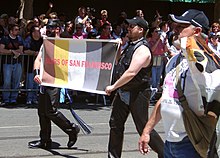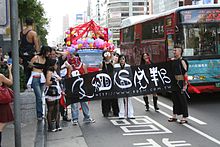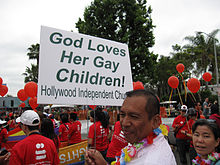
Sexuality and gender identity-based cultures are subcultures and communities composed of people who have shared experiences, backgrounds, or interests due to common sexual or gender identities. Among the first to argue that members of sexual minorities can also constitute cultural minorities were Adolf Brand, Magnus Hirschfeld, and Leontine Sagan in Germany. These pioneers were later followed by the Mattachine Society and the Daughters of Bilitis in the United States.
Not all persons of various gender and sexual orientations self-identify or are affiliated with a particular subculture. Reasons include geographic distance, unawareness of the subculture's existence, fear of social stigma, or personal preference to remain unidentified with sexuality- or gender-based subcultures or communities. Some have suggested that the identities defined by the Western heterosexualized cultures are based on sexuality. They also have serious flaws and often leave no space for the public to discuss these flaws of gender and sexuality. Because there are no safe spaces to discuss these things, many people reject who they are and ignore their own sexual needs. This rejection can lead to these people being classified under sexual identities that they feel do not represent them as a person. These cultures are currently changing. For example, Greece recently legalized gay marriage, taking a huge step for an Orthodox country.
LGBTQ+ culture
Main article: LGBTQ culture

LGBTQ+ culture is the common culture shared by lesbian, gay, bisexual, transgender, and queer communities. It is sometimes simply referred to as "queer culture" or "gay culture", but the latter term can also be specific to gay men's culture.
LGBT culture varies widely by geography and the identity of the participants. Elements often identified as being common to the culture of gays, lesbians, bisexuals, and transgender people include:
- The work of famous gay, lesbian, bisexual and transgender people. This may include:
- Present-day LGBTQ+ artists and political figures;
- Historical figures who have been identified as LGBTQ+. It has often been questioned whether it is appropriate to identify historical figures using modern terms for sexual identity (see History of sexuality). However, many LGBTQ+ people feel a kinship towards these people and their work, especially to the extent that it deals with same-sex attraction or gender identity.
- An understanding of the history of LGBTQ+ political movements.
- An ironic appreciation of things linked by stereotype to LGBTQ+ people.
- Figures and identities that are present in the LGBTQ+ community and LGBTQ+ culture, this could include the gay village, drag kings and queens, LGBTQ+ pride, and the rainbow flag.
In some cities, especially in North America, gay men and lesbians tend to live in certain neighbourhoods that celebrate or support their community.
LGBTQ+ communities organize a number of events to celebrate their culture, such as Pride parades, the Gay Games and Southern Decadence.
Polyamory
Main article: Polyamory
Polyamory is the practice and associated culture of being romantically connected or involved with more than one person simultaneously and consensually, which is distinct yet entwined with polysexuality, the practice of having more than one sexual partner. Polyamory can occur in a social group, culture, or group of people specific to a certain gender-identity or sexual orientation. In some cultures the practice of forming multiple simultaneous romantic relationships is controversial.

Polygamy (a practice that overlaps heavily with polyamory) is the practice of legally marrying more than one person. It is against the law to marry more than one person in the United States; however, there are some countries around the world where polygamy and/or polyamorous relationships are not unusual. For example, it is not uncommon in many middle eastern cultures for men to have multiple wives. This type of polyamorous relationship is known as polygyny, whereas the opposite, in which women have multiple husbands, is called polyandry.
The illegal status of multiple marriages in many parts of the world has not stopped the formation of communities and sub-cultures that practice polyamory and informal polygamy. There are several accounts of attempted private polygamist communities in Western Europe and North America. However, these communities, for the most part, have eventually disbanded. In Western culture there are few or no examples of widespread acceptance of polyamory. This does not mean that polyamorous relationships in Western culture (and subcultures) do not exist. In the United States it is estimated that polyamory is practiced by 4-5% of the population. Polyamory exists mainly as isolated instances in which those in relationships have made agreements with their significant other(s).
Sexual fetish-based cultures
Main article: Sexual fetishism
The fetish subculture is a subculture that comprises people with a broad range of sexual fetishes and other paraphilias. Alternative terms for the fetish subculture include fetish scene and fetish community.
This subculture is often seen highlighting a strong nightclub scene, in the form of fetish clubs.
Some of the most common paraphilias seen in the fetish subculture include BDSM, leather fetishism and rubber fetishism. The subculture itself allows for people to come together and share their common interests in regards to sexual fetishes, permitting for a safe and supportive environment. However, there is typically a negative stigma associated with this subculture as it encourages the uncommon discussion and indulging of sexual desires in society. This often results in people rejecting such subcultures or associating it with other cultures that explore such topics, thus including the LGBTQ+ culture.
Influence on mainstream culture
Sexual minority cultures frequently and consistently influence each other. Yale sociology professor Joshua Gamson argues that the tabloid talk show genre, popularized by Oprah Winfrey in the 1980s provided a much needed, high impact media visibility for sexual minorities and did more to make gay culture mainstream than any other development of the 20th century. Slang frequently originates in subcultures, including sexual minority subcultures, which becomes part of the larger vernacular including words associated with descriptions specific to sexual minorities or not.
Madonna is one of many artists who have borrowed from sexual minority cultures, including her appropriation of vogueing. Recently, the television series Queer Eye for the Straight Guy depicts straight men being given fashion make-overs or decorating tips from gay men.
Non-Western cultures
In 2006, Thai film Rainbow Boys produced by Vitaya Saeng-aroon, depicting a contemporary gay relationship, had a limited-release screening. Vitaya also produced the comedy-drama Club M2, set in a gay sauna. The significance of the film is found in its novelty in a society very similar, if not more traditional, than the West as regards assigned gender roles and attractions. Another 2007 film, Bangkok Love Story, directed by Poj Arnon, was critically hailed as a departure from the stereotyped view of homosexuals as transvestites and transsexuals. Gay Thai independent film producer Vitaya Saeng-aroon praised the film, saying, "Director Poj Arnon was brave enough to shake society up." These people made breakthroughs with their films as other scholars and public authors also began to bring the issue of gender and stereotypes to the forefront as a more over the rug topic in contemporary culture. In many countries, homosexuality and bisexuality are widely accepted and often legal, although often still face discrimination and criticism. In this context, "queer youth are often cast as victims of homophobic violence or heterosexist exclusion in ways that inscribe them within tropes of victimization and risk."
Unlike European cultures which are primarily based in Christian religion and held up many anti-LGBT laws until recently, the Chinese culture was much more open about non-exclusively-heterosexual relationships. "For a period of the modern history of both the Republic of China and People's Republic of China in the 20th century, LGBT people received more stringent legal regulations regarding their orientations, with restrictions being gradually eased by the beginning of the 21st century." Though there were still restrictions in the ancient Chinese culture, homosexual relations have been documented since early historical periods. There were recordings of subcultures of prostitute/actors also in existence; however, even in modern-day Chinese culture, there are those who are opposed to outside heterosexual relationships and lifestyles. In the People's Republic of China, "Reportedly, Mao Zedong believed in the sexual castration of "sexual deviants", but little is known about the Communist Chinese governments official policy with regards to homosexuality prior to the 1980s."
Many Japanese have adopted wide ranges of sexual identity, and space has always existed for non-exclusively hegemonic gender roles in Japanese society. The modern era, however, has made more room for those openly varied gender roles. Before Western contact, Japan did not have a system of identification in which one's identity was determined by one's biological sexual preference (see Sexual minorities in Japan). Yet, hegemonic notions of how men and women should behave are still strong in the country, as in the Western cultures. Earlier studies on sex roles and gender identities in Asia focused heavily on particular constraints felt by women, for "' models of citizenship implicitly privilege the male, white-collar 'citizen in a suit.'" Constraints are also felt, however, on the males in Asian societies who are held at a higher standard due to the "dominant paradigm" referred to as "hegemonic masculinity". Arguments present ideas that "masculinity" has a history and is actually not only expressed differently in different societies but also differently within societies throughout eras. Masculinity, even in traditional Asian cultures is, so called, plural. Still, certain forms of masculinity (and femininity for that matter) become particularly privileged, the hegemonic masculinity.
Activism and Advocacy
Main article: LGBTQ movementsEarly movements

LGBTQ+ activism in the United States can be traced back to William Dorsey Swann, the first known person to openly identify as a "queen of drag." In the late 1800s, Swann organized one of the earliest documented LGBTQ+ gatherings, where attendees, primarily men, dressed in women's clothing, marking an early form of organized resistance against discrimination. In 1924, Henry Gerber, a German immigrant and early gay rights advocate, founded the Society for Human Rights in Chicago, one of the first organizations in the U.S. dedicated to advancing homosexual rights. Gerber wrote about homosexual oppression in an attempt to build solidarity and advocate for the community.
In 1950, activist Harry Hay founded the Mattachine Society, one of the earliest enduring LGBTQ+ rights organizations in the U.S. The society worked to raise awareness, educate members, and connect the pursuit of social justice with LGBTQ+ rights. In 1955, Del Martin and Phyllis Lyon established the Daughters of Bilitis, the first organization in the U.S. devoted specifically to lesbian advocacy, providing support, and promoting visibility for lesbian women.
LGBTQ+ organizations
Main article: LGBTQ rights organizationNumerous organizations emerged in the 20th and 21st centuries to advance LGBTQ+ rights globally. The Human Rights Campaign (HRC) and Lambda Legal are U.S. organizations focused on advancing legal protections and promoting social acceptance for LGBTQ+ individuals, particularly those who are transgender, people of color, or living with HIV, to ensure they are recognized as full and equal citizens. International Lesbian, Gay, Bisexual, Trans, and Intersex Association (ILGA) campaigns for freedom and equality for all, regardless of sexual orientation or gender identity, across continents. OutRight Action International supports LGBTQ+ individuals in restrictive regions, engaging in advocacy, providing legal aid for asylum seekers, and leading crisis interventions for LGBTQ+ communities.

See also
- Asexuality
- Bisexuality
- Gay community
- Gay village
- Sexual diversity
- Non-westernized concepts of male sexuality
- LGBTQ history in China
- LGBTQ history
- LGBTQ rights in Taiwan
- LGBTQ social movements
- Polyamory
- Queer
- Separatism
- Sexual minorities in Japan
- Sexual orientation
- Third gender
- Travesti (gender identity)
References
- Goicichea, Julia (August 16, 2017). "Why New York City Is a Major Destination for LGBT Travelers". The Culture Trip. Retrieved February 2, 2019.
- Rosenberg, Eli (June 24, 2016). "Stonewall Inn Named National Monument, a First for the Gay Rights Movement". The New York Times. Retrieved June 25, 2016.
- "Workforce Diversity The Stonewall Inn, National Historic Landmark National Register Number: 99000562". National Park Service, U.S. Department of the Interior. Retrieved April 21, 2016.
- Smith, Helena (February 15, 2024). "Greece becomes first Orthodox Christian country to legalize same-sex marriage". The Guardian. London. Retrieved March 13, 2024.
- Morgan, Dee (July 31, 2022). "The History of Polyamory Flags". polyamproud. Retrieved October 28, 2024.
Symbolism: blue - representing openness and honesty amongst partners; red - representing love and passion; black representing solidarity with those who are forced to hide their polyam relationships due to societal pressures. The pi symbol references the word 'polyamory' as it also starts with 'p'; and the gold of the pi symbol represents the value placed on emotional attachment (friendly and/or romantic), not just physical connections.
- Stitt, Alex (2020). ACT For Gender Identity: The Comprehensive Guide. London: Jessica Kingsley Publishers. ISBN 978-1785927997. OCLC 1089850112.
- Zane, Zachary (November 12, 2018). "Who Really Practices Polyamory?". Rolling Stone. Retrieved July 12, 2021.
- ^ "The real pride in being gay". The Nation. Bangkok. November 3, 2007. Archived from the original on November 6, 2007.
- Driver, Susan (2008). Introducing Queer Youth Cultures. New York University Press. pp. 3–4. ISBN 978-0-7914-7337-5.
- Harris, Bond Michael (2010). The Oxford Handbook of Chinese Psychology. Oxford University Press. p. 222.
- ^ , Mark McLelland and Romit Dasoupta, "Queer studies" in postwar Japan; 2005, Routledge
- Suzuki, N. Introduction. Men and Masculinities in Contemporary Japan: Dislocating the Salaryman Doxa. By J. Roberson. London: Routledge, 2003. 97-99. Print.
- Magazine, Smithsonian; Shane, Cari. "The First Self-Proclaimed Drag Queen Was a Formerly Enslaved Man". Smithsonian Magazine. Retrieved November 1, 2024.
- "7 Early Pioneers of the Gay Rights Movement". HISTORY. June 8, 2023. Retrieved November 1, 2024.
- "HENRY GERBER – Chicago LGBT Hall of Fame". Retrieved November 1, 2024.
- "Mattachine Society | Founder, Purpose, Goals, & Stonewall Riots | Britannica". www.britannica.com. Retrieved November 1, 2024.
- Magazine, Smithsonian; Anderson, Gracie. "The Incredible Story of Lesbian Activists Del Martin and Phyllis Lyon". Smithsonian Magazine. Retrieved November 1, 2024.
- "About". HRC. Retrieved November 1, 2024.
- "WORLD Policy Analysis Center". www.worldpolicycenter.org. Retrieved November 1, 2024.
- "Our Purpose | Outright International". outrightinternational.org. Retrieved November 1, 2024.
Further reading
- Cante, Richard C. (March 2009). Gay Men and the Forms of Contemporary US Culture. London: Ashgate Publishing. ISBN 978-0-7546-7230-2.
- De La Torre, Miguel A. (2009). Out of the Shadows, into the Light: Christianity and Homosexuality. St. Louis, Missouri: Chalice Press. ISBN 978-0-8272-2727-9.
External links
- The Androphile Project Extensive resource of gay and bisexual history
- The Gay, Lesbian, Bisexual, Transgender Historical Society
| Gender and sexual identities | |||||||||
|---|---|---|---|---|---|---|---|---|---|
| Gender identities |
| ||||||||
| Sexual orientation identities |
| ||||||||
| See also | |||||||||